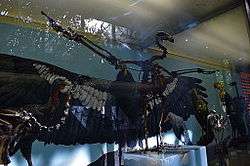Gymnogyps amplus
| Gymnogyps amplus Temporal range: Late Pleistocene – Holocene | |
|---|---|
 | |
| Fossil skeleton from the La Brea Tar Pits | |
| Scientific classification | |
| Kingdom: | Animalia |
| Phylum: | Chordata |
| Class: | Aves |
| Order: | Cathartiformes |
| Family: | Cathartidae |
| Genus: | Gymnogyps |
| Species: | G. amplus |
| Binomial name | |
| Gymnogyps amplus L. H. Miller, 1911 | |
Gymnogyps amplus is an extinct species of large New World vultures in the family Cathartidae. The species was first described by L. H. Miller in 1911 from a broken tarsometatarsus.[1][2]
The species is the only condor species found in the La Brea Tar Pits' Pit 10, which fossils date to "a Holocene radiocarbon age of 9,000 years."[2] The smaller, modern California condor may have evolved from G. amplus.[2]
References
| Wikimedia Commons has media related to Gymnogyps amplus. |
- ↑ Nadin, Elisabeth (26 October 2007). "Tracing the Roots of the California Condor". Caltech News. California Institute of Technology. Retrieved 11 October 2015.
- 1 2 3 Syverson, Valerie J.; Prothero, Donald R. (2010). "Evolutionary Patterns in Late Quaternary California Condors" (PDF). PalArch's Journal of Vertebrate Palaeontology. PalArch Foundation. 7 (1): 1–18. Retrieved 11 October 2015.
This article is issued from Wikipedia - version of the 4/17/2016. The text is available under the Creative Commons Attribution/Share Alike but additional terms may apply for the media files.